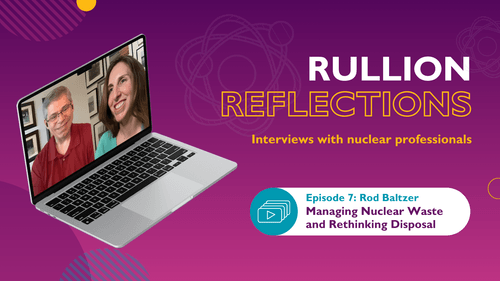Delivering AMP8: Solving the Water Sector’s Talent Challenge
With AMP8 (Asset Management Period 8) now underway, the UK water sector is entering one of the most ambitious investment periods in its history. Over the next five years, more than £88 billion will be channelled into infrastructure upgrades, pollution control, resilience planning, and digital transformation. Yet the success of AMP8 will not be determined by funding alone. It will be determined by people. And while the regulatory focus is sharp, it is the strength of the workforce that will ultimately determine success.
Rullion is a leading provider of workforce solutions, specialising in helping critical infrastructure organisations, including major UK water companies, to get work done. For over a decade, we’ve partnered with the sector to deliver agile, inclusive, and future-ready talent strategies. This includes our work with Northumbrian Water Group, where we mobilised a fully embedded workforce solution in under four weeks, safeguarding contractors and ensuring continuity from day one.
AMP8 brings the most ambitious expectations ever placed on the UK water industry:
-
Reduce pollution and storm overflows
-
Deliver measurable progress toward Net Zero
-
Improve affordability and customer service
-
Embrace digital tools and smart infrastructure
-
Integrate nature-based and resilient solutions
Each of these priorities demands a workforce that is capable, motivated, and equipped to deliver - across both permanent and contingent roles. Without the right talent strategy, investment targets and project outcomes risk falling short.
A New Era of Complexity, Accountability and Innovation
The challenges of AMP8 go far beyond technical delivery. Utilities face rising customer expectations, increased regulatory scrutiny, and a competitive talent market that extends well beyond the sector. Digital transformation is accelerating across the utilities sector. This acceleration and pressure to transform is having an unavoidable impact on water companies and their ability to effectively resource projects as the skills needed to support are in short supply.
The sector’s long-term resilience will depend on how well organisations can adapt their workforce strategies now - before skills shortages become critical roadblocks.
The Three Major Issues
For all its ambition, the water sector enters AMP8 with a growing talent gap. Existing workforce strategies are under pressure and in many cases, outdated.
1. An Ageing Workforce
Almost a third of the industry’s workforce is nearing retirement. Without effective knowledge transfer and succession planning, utilities face the loss of decades of technical expertise and operational experience - skills that can’t be replaced overnight. Rullion helps water companies tackle this challenge head-on by:
-
Embedding succession planning into workforce strategies so knowledge is retained, not lost.
-
Combining behaviour-first hiring with mentoring programmes to bring in early-career talent who can learn directly from experienced professionals before they retire.
-
Using our Managed Service Programme (MSP) to track skills data across the contingent workforce, identifying potential gaps years in advance and planning resourcing accordingly.
This approach not only preserves institutional knowledge but ensures organisations are continuously building capability for the future, rather than reacting after critical skills have already walked out the door.
2. Digital and Delivery Skills Gaps
The digitalisation of asset management, data analytics, and cyber-secure operations is outpacing current talent pipelines. The result? Skills gaps in key areas like project delivery, engineering, and smart infrastructure implementation - all of which are essential for AMP8 success. Rullion bridges these gaps by:
-
Partnering with clients to map emerging skills needs linked to AMP8’s digital and transformation goals.
-
Using our Train to Deploy model to upskill candidates into roles such as data engineers, SCADA specialists, and digital project managers.
-
Taking a sector-agnostic view of talent by identifying people from other industries (e.g., energy, manufacturing, defence) with transferable digital skills and preparing them for water-sector delivery.
-
Leveraging our MSP for utilities to ensure project-critical roles are filled quickly without compromising on quality or compliance.
By combining proactive workforce planning with targeted skills creation, we help utilities keep pace with digital transformation, rather than playing catch-up.
3. Competing for Scarce Talent
The water industry is no longer competing solely with other utilities. Water companies are now recruiting in the same pool as energy, renewables, and tech; sectors which often offer more competitive packages. To succeed water companies must rethink what makes their workforce strategy competitive, sustainable, and future-ready. And ultimately what differentiates them as an employer of choice.
Right now, most of the conversation focuses on what the sector lacks - an ongoing shortage of engineering, project delivery, and digital skills. But what if we reframed the challenge? Across the UK, there is an abundance of people with the right behaviours, values, and potential to thrive in these roles. The opportunity lies in unlocking that potential through targeted training and development.
That’s why forward-thinking utilities are starting to invest in models like Train to Deploy, which create the skills needed for AMP8 rather than competing endlessly for a limited external talent pool.
Rethinking Workforce Strategy for AMP8
Meeting the challenges of AMP8 requires more than reactive hiring. It calls for strategic, agile workforce solutions that can scale with demand, address niche skills gaps, and embed diversity and inclusion from the outset. At Rullion, we help water and utilities organisations transition from short-term resourcing to sustainable workforce transformation.
1. Scalable MSP Solutions for Utilities
Our Managed Service Programme (msp) model provides:
-
Greater visibility and control over contingent workforce spend
-
Reduced time-to-hire across critical roles
-
Optimised supplier performance
-
Seamless compliance and risk mitigation
-
Talent data and planning aligned to AMP8 milestones
Our partnership with Northumbrian Water Group demonstrates what this looks like in practice - rapid mobilisation, robust governance, and a collaborative approach that puts people at the centre. Explore the full case study to see how Rullion helped NWG mobilise a fully embedded workforce solution in under four weeks.
2. Train to Deploy: Building Skills, Not Just Hiring Them
Where talent is scarce, our Train to Deploy solution helps organisations develop it. We can identify high-potential candidates through behaviour-first hiring, train them in the technical skills required for AMP8, and deploy them into critical roles.
Benefits include:
-
Behaviour-first hiring based on mindset and potential
-
Customised training aligned to technical and regulatory needs
-
More inclusive and diverse talent pipelines
-
Stronger long-term retention and team capability
This approach enables utilities to future-proof their workforce by building capability from within, rather than relying solely on an increasingly competitive external market. It’s a smarter way to build the talent you need and avoid just search endlessly for it.
“Train to Deploy helps water companies move from reactive hiring to proactive workforce planning by building pipelines of talent designed around AMP8’s critical roles, operational teams, and long-term sector goals.” – Dan Crerand, Train to Deploy Director
From Filling Roles to Building Readiness
AMP8 is about more than delivering projects. It’s an opportunity to rethink how the water sector builds, supports, and develops its workforce for the long term. While filling vacancies will always be part of the picture, the organisations that will thrive are those that plan, create talent pipelines, and adapt their strategies as the sector evolves.
Readiness means having the right people in place at the right time - not by chance, but through careful planning, investment in skills, and a commitment to developing talent from within. It’s about recognising the abundance of skills that already exists and finding new ways to unlock potential through training, reskilling, and inclusive hiring.
At Rullion, we work alongside major UK water companies to put these principles into practice; delivering workforce solutions for utilities that are agile, scalable, and designed to support both immediate goals and long-term ambitions. With the right approach, AMP8 can set the foundations for a more capable, adaptable, and future-ready sector.





